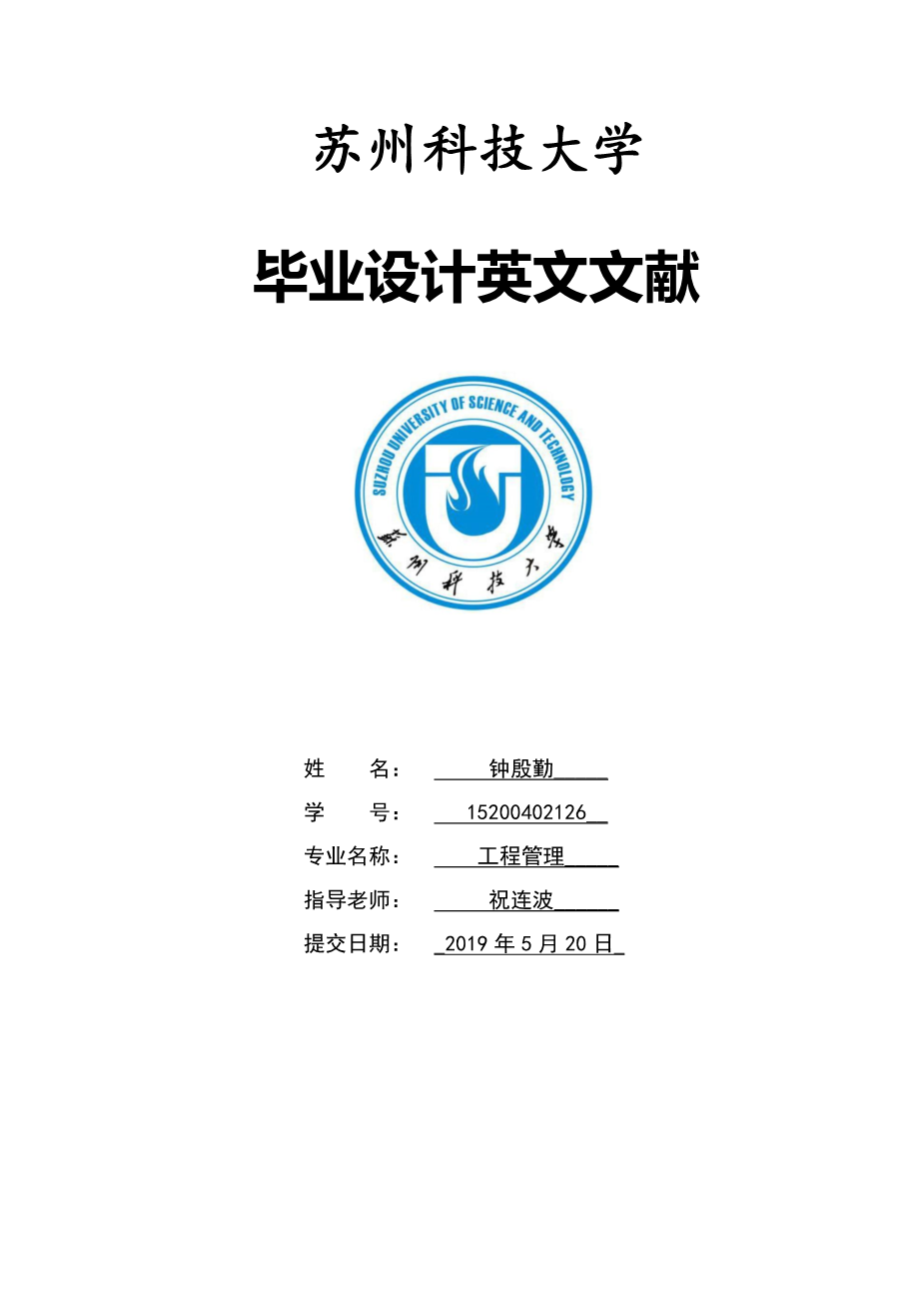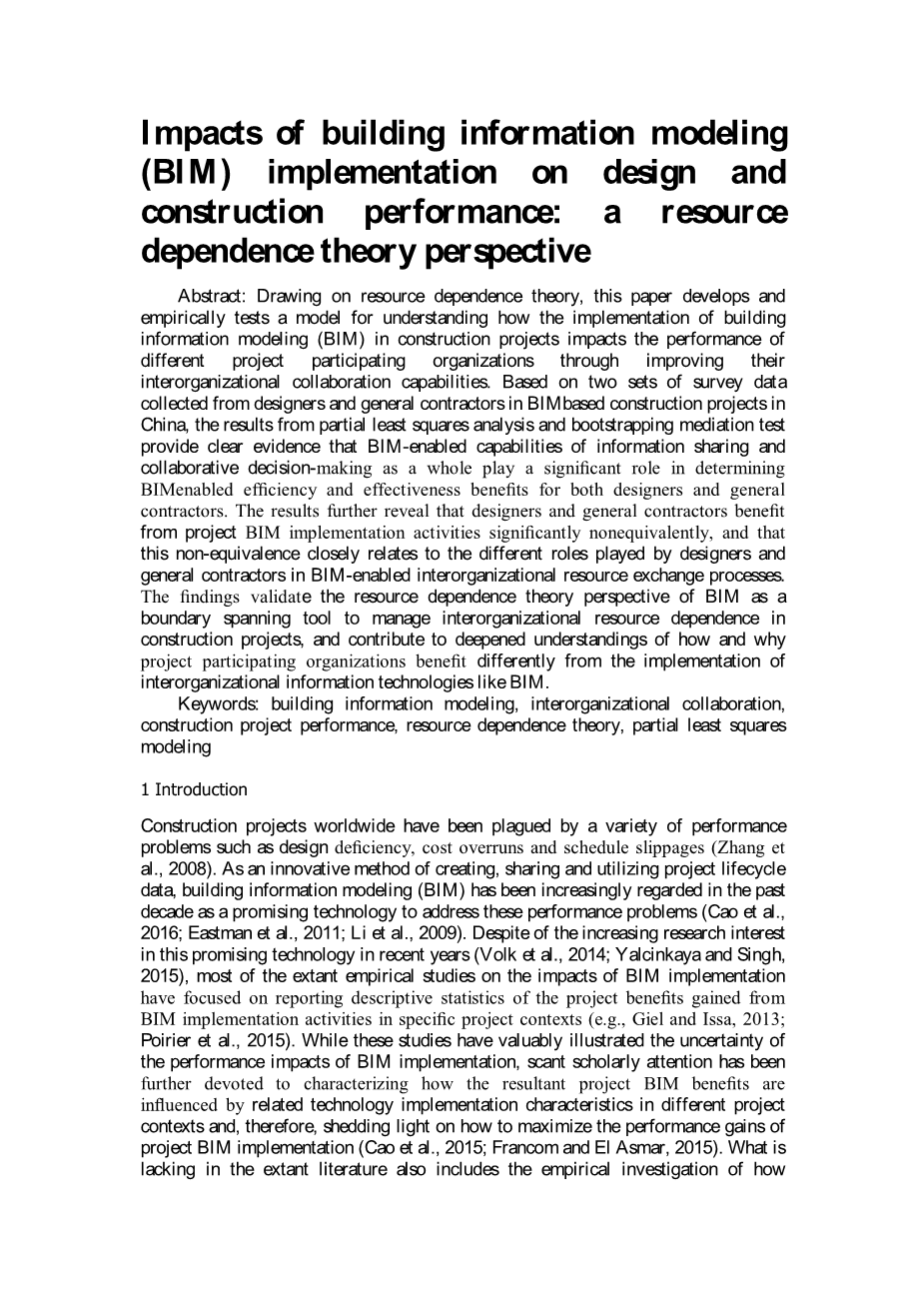苏州科技大学
毕业设计英文文献
文献题目: Impacts of building information modeling (BIM) implementation on design and construction performance: a resource dependence theory perspective
建筑信息模型(BIM)实施对设计和施工性能的影响:资源依赖理论的观点
姓 名: 钟殷勤_____
学 号: 15200402126__
专业名称: 工程管理_____
指导老师: 祝连波______
提交日期: _2019年5月20日_
Abstract
Drawing on resource dependence theory, this paper develops and empirically tests a model for understanding how the implementation of building information modeling (BIM) in construction projects impacts the performance of different project participating organizations through improving their interorganizational collaboration capabilities. Based on two sets of survey data collected from designers and general contractors in BIMbased construction projects in China, the results from partial least squares analysis and bootstrapping mediation test provide clear evidence that BIM-enabled capabilities of information sharing and collaborative decision-making as a whole play a significant role in determining BIMenabled efficiency and effectiveness benefits for both designers and general contractors. The results further reveal that designers and general contractors benefit from project BIM implementation activities significantly nonequivalently, and that this non-equivalence closely relates to the different roles played by designers and general contractors in BIM-enabled interorganizational resource exchange processes. The findings validate the resource dependence theory perspective of BIM as a boundary spanning tool to manage interorganizational resource dependence in construction projects, and contribute to deepened understandings of how and why project participating organizations benefit differently from the implementation of interorganizational information technologies like BIM.
Keywords building information modeling, interorganizational collaboration, construction project performance, resource dependence theory, partial least squares modeling
1 Introduction
Construction projects worldwide have been plagued by a variety of performance problems such as design deficiency, cost overruns and schedule slippages (Zhang et al., 2008). As an innovative method of creating, sharing and utilizing project lifecycle data, building information modeling (BIM) has been increasingly regarded in the past decade as a promising technology to address these performance problems (Cao et al., 2016; Eastman et al., 2011; Li et al., 2009). Despite of the increasing research interest in this promising technology in recent years (Volk et al., 2014; Yalcinkaya and Singh, 2015), most of the extant empirical studies on the impacts of BIM implementation have focused on reporting descriptive statistics of the project benefits gained from BIM implementation activities in specific project contexts (e.g., Giel and Issa, 2013; Poirier et al., 2015). While these studies have valuably illustrated the uncertainty of the performance impacts of BIM implementation, scant scholarly attention has been further devoted to characterizing how the resultant project BIM benefits are influenced by related technology implementation characteristics in different project contexts and, therefore, shedding light on how to maximize the performance gains of project BIM implementation (Cao et al., 2015; Francom and El Asmar, 2015). What is lacking in the extant literature also includes the empirical investigation of how different types of participating organizations benefit differently from project BIM implementation activities. Different from other technologies like two-dimensional computer-aided design (2D CAD), BIM is a typical interorganizational innovation whose implementation process not only requires the cooperation of multiple project participating organizations but could also generate performance impacts spilling over organizational boundaries (Cao et al., 2015; Taylor, 2007). While research on interorganizational relationships in other industries suggests that perceived inequity in the allocation of collaborative benefits could substantially jeopardize related collaborative “pie-expansion” efforts (Scheer et al., 2003), extant research on the performance impacts of project BIM implementation in the construction industry has focused on assessing related performance gains from the perspective of a whole project (Francom and El Asmar, 2015; Smits et al., 2016) or a specific participating organization (Poirier et al., 2015; Sacks and Barak, 2008). By contrast, limited empirical evidence has been provided to characterize BIM implementation benefits gained by different project participating organizations in a comparative manner and thus offer insights into how to better address potential “pie-sharing” problems and incentivize collaborative “pie-expansion” efforts during project BIM implementation processes. Drawing on resource dependence theory (Pfeffer and Salancik,1978),this study aims to develop and empirically test a model for examining how project BIM implementation activities impact the performance of different project participating organizations from an interorganizational resource exchange perspective. Using resource dependence theory as a lens to understand BIM as a boundary spanning tool for project participating organizations to manage interorganizational dependence, the model specifically featuresBIM-enabled interorganizational collaboration capabilities (including information sharing capability and collaborative decision-making capability) as important factors determining the resultant performance gains from BIM implementation in construction projects. Considering the important roles of designers and general contractors in executing project design and construction activities, the model was empirically tested using two separate
剩余内容已隐藏,支付完成后下载完整资料


英语译文共 12 页,剩余内容已隐藏,支付完成后下载完整资料
资料编号:[440366],资料为PDF文档或Word文档,PDF文档可免费转换为Word


